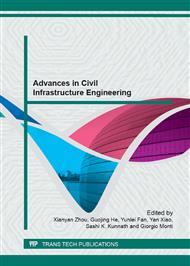p.474
p.481
p.485
p.489
p.493
p.498
p.502
p.510
p.515
An Experimental Study on the Creep of FRC Sub-Base for Pavement Using a New Testing Device
Abstract:
The hydraulic loading device commonly used for creep test necessitates continuous recharge of the hydraulic pressure with time and is accompanied by slight variation of the permanent load at each recharge. Therefore, accurate test results cannot be obtained for long-term creep tests requiring time-dependent behavioral analysis during more than 6 months. This study conducts creep test as part of the analysis of the long-term characteristics of fiber-reinforced lean concrete sub-base of pavement. The creep test is executed using the new load-amplifier device not a conventional loading device. Since the results of the preliminary verification test on the new creep test device show that constant permanent load is applied without significant variation, it can be expected that more accurate measurement of the creep will be possible in a long-term compared to the conventional hydraulic device. In addition, the creep test results of sub-base specimens reveal the occurrence of large instantaneous elastic strain, differently from the strain curve observed in ordinary concrete, as well as the occurrence of small creep strain leading to low creep coefficient.
Info:
Periodical:
Pages:
493-497
Citation:
Online since:
January 2013
Authors:
Keywords:
Price:
Сopyright:
© 2013 Trans Tech Publications Ltd. All Rights Reserved
Share:
Citation:


